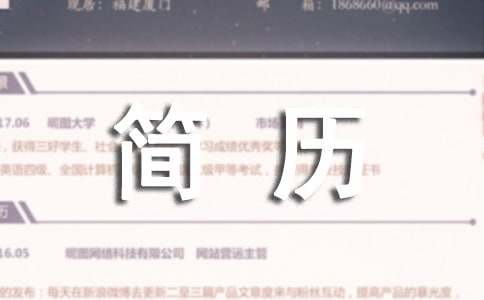- 相關推薦
英文簡歷書寫要求
1. What IS a resume anyway?

Remember: a Resume is a self-promotional document that presents you in the best possible light, for the purpose of getting invited to a job interview. It''s not an official personnel document. It''s not a job application. It''s not a "career obituary"! And it''s not a confessional.
2. What should the resume content be about?
It''s not just about past jobs! It''s about YOU, and how you performed and what you accomplished in those past jobs--especially those accomplishments that are most relevant to the work you want to do next. A good resume predicts how you might perform in that desired future job.
3. What''s the fastest way to improve a resume?
Remove everything that starts with "responsibilities included" and replace it with on-the-job accomplishments. (See Tip 11 for one way to write them.)
4. What is the most common resume mistake made by job hunters?
Leaving out their Job Objective! If you don''t show a sense of direction, employers won''t be interested. Having a clearly stated goal doesn''t have to confine you if it''s stated well.
5. What''s the first step in writing a resume?
Decide on a job target (or "job objective") that can be stated in about 5 or 6 words. Anything beyond that is probably "fluff" and indicates a lack of clarity and direction.
6. How do you decide whether to use a Chronological resume or a Functional one?
The Chronological format is widely preferred by employers, and works well if you''re staying in the same field (especially if you''ve been upwardly-mobile). Only use a Functional format if you''re changing fields, and you''re sure a skills-oriented format would show off your transferable skills to better advantage; and be sure to include a clear chronological work history!
7. What if you don''t have any experience in the kind of work you want to do?
Get some! Find a place that will let you do some volunteer work right away. You only need a brief, concentrated period of volunteer training (for example, 1 day a week for a month) to have at least SOME experience to put on your resume. Also, look at some of the volunteer work you''ve done in the past and see if any of THAT helps document some skills you''ll need for your new job.
8. What do you do if you have gaps in your work experience?
You could start by looking at it differently. General Rule: Tell what you WERE doing, as gracefully as possible--rather than leave a gap. If you were doing anything valuable (even if unpaid) during those so-called "gaps" you could just insert THAT into the work-history section of your resume to fill the hole. Here are some examples:
1993-95 Full-time parent -- or
1992-94 Maternity leave and family management -- or
Travel and study -- or Full-time student -- or
Parenting plus community service
9. What if you have several different job objectives you''re working on at the same time? Or you haven''t narrowed it down yet to just one job target?
Then write a different resume for each different job target. A targeted resume is MUCH, much stronger than a generic resume.
10. What if you have a fragmented, scrambled-up work history, with lots of short-term jobs?
To minimize the job-hopper image, combine several similar jobs into one "chunk," for example:
1993-1995 Secretary/Receptionist; Jones Bakery, Micro Corp., Carter Jewelers -- or
1993-95 Waiter/Busboy; McDougal''s Restaurant, Burger King, Traders Coffee Shop.
Also you can just drop some of the less important, briefest jobs. But don''t drop a job, even when it lasted a short time, if that was where you acquired important skills or experience.
11. What''s the best way to impress an employer?
Fill your resume with "PAR" statements. PAR stands for Problem-Action-Results; in other words, first you state the problem that existed in your workplace, then you describe what you did about it, and finally you point out the beneficial results.
Here''s an example: "Transformed a disorganized, inefficient warehouse into a smooth-running operation by totally redesigning the layout; this saved the company thousands of dollars in recovered stock."
Another example: "Improved an engineering company''s obsolete filing system by developing a simple but sophisticated functional-coding system. This saved time and money by recovering valuable, previously lost, project records."
【英文簡歷書寫要求】相關文章:
英文簡歷的寫作要求03-07
不同企業對英文簡歷的要求01-15
英文簡歷寫作規范要求01-18
英文簡歷寫作要求與建議02-27
英文簡歷的寫作要求與技巧03-07
英文簡歷寫作要求與技巧12-27
各國外企對英文簡歷的要求01-16
英文簡歷書寫格式及注意事項01-11
英文簡歷的7個基本要求02-20